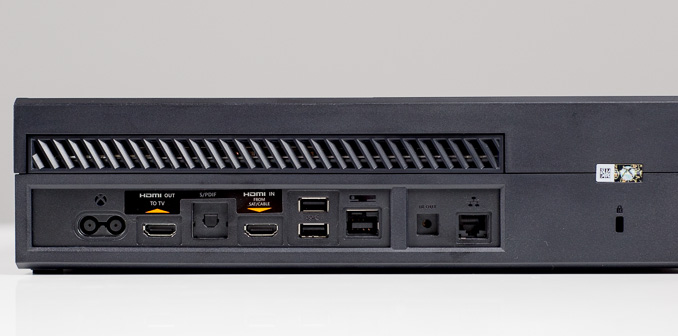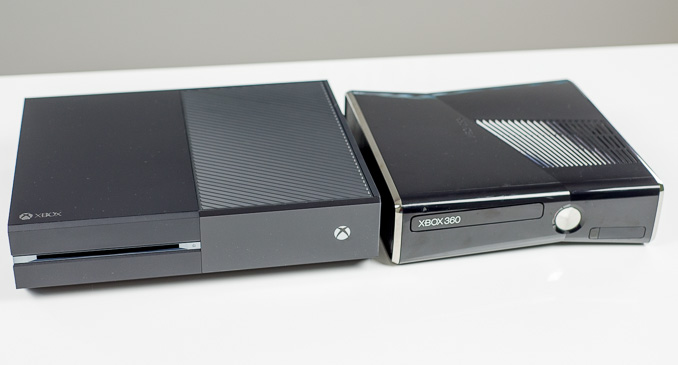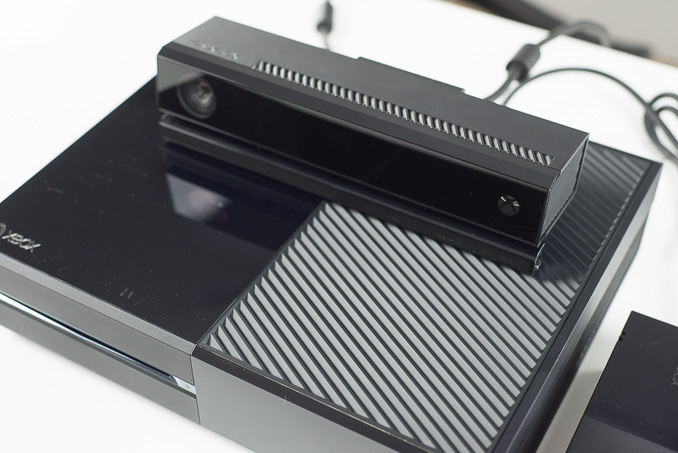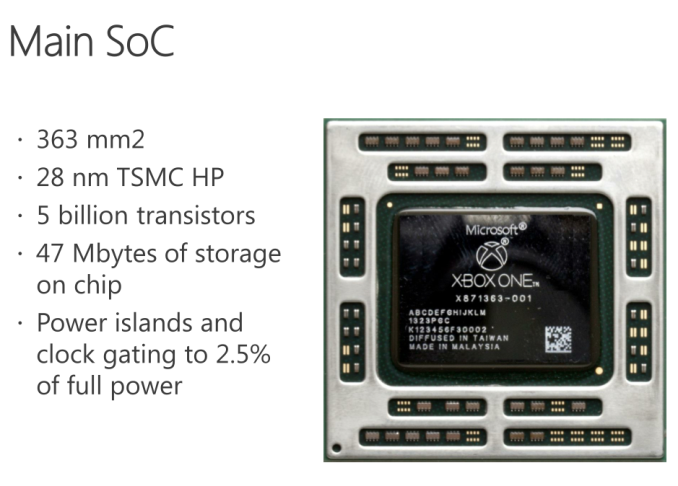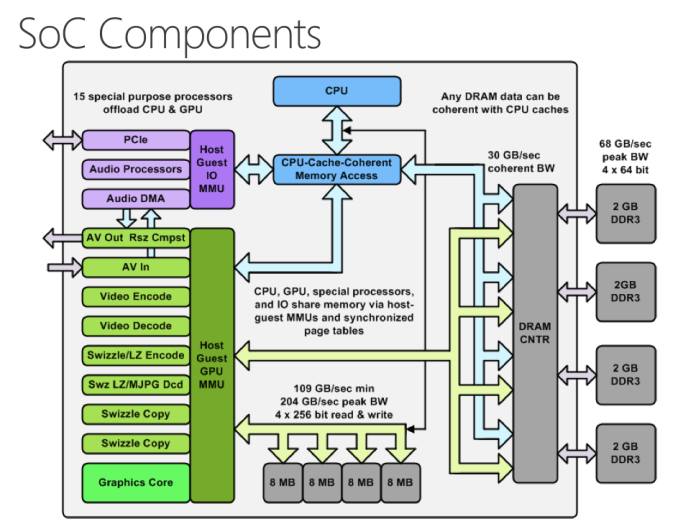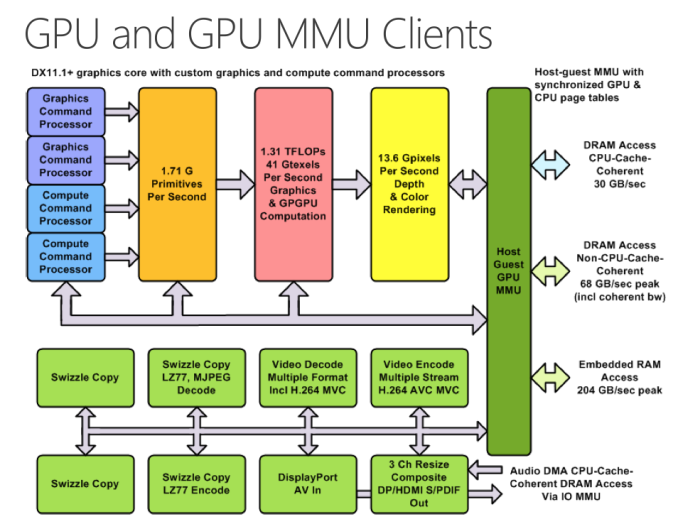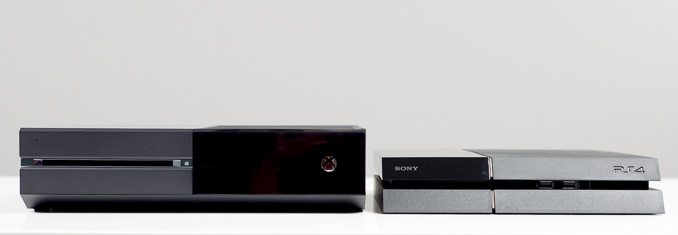
Original Link: https://www.anandtech.com/show/7528/the-xbox-one-mini-review-hardware-analysis
The Xbox One - Mini Review & Comparison to Xbox 360/PS4
by Anand Lal Shimpi on November 20, 2013 8:00 AM EST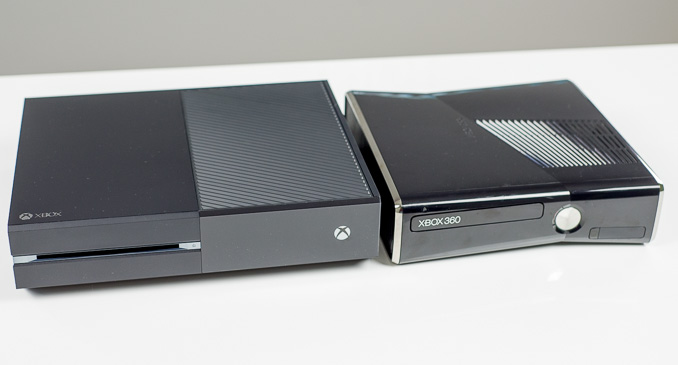
Earlier this morning Microsoft lifted the embargo on press reviews of the Xbox One. I’ve been playing with final hardware and near final software for a few days now and I wanted to share some thoughts. This is by no means one of our usual thorough review jobs, just a side quest I found myself on over the past few days.
I like the look of the Xbox One. I wish it felt a little more durable, but perhaps that’s the mobile side of me speaking where materials are a bigger deal. Sitting on a stand, desk or rack from across the room the One looks clean, simple and honestly, it looks like an Xbox. The Xbox 360 was a journey into a weird sort of industrial design that was a significant departure from the original. The past couple of revisions of the 360 have moved towards sharper angles and away from the curves of the original 360. The One completes the journey back to its roots. Dare I say it almost looks like a PC, and if you crack open the chassis you’ll be reminded of the same.
I’ll start with IO on the sides and back. There’s a single USB 3.0 port on the left side of the chassis, with two more on the rear of the machine. Support for external storage is apparently on its way, as the Xbox One doesn’t allow end user upgrades of the internal 500GB hard drive. I have to say that I prefer Sony’s stance on this one.
Gigabit Ethernet and dual-band 802.11n WiFi handle Internet connectivity. I’m still shocked that the PS4 shipped with 2.4GHz only WiFi in 2013. On the AV front there’s an optical output and HDMI in/out. Kinect has its own port on the rear of the chassis and there’s an IR port as well. There’s a Kensington security slot to the right of all of the IO on the Xbox One.
The ring of light from the Xbox 360 is gone and replaced with a single, white, backlit Xbox logo on the front of the console. You’ll notice the controller position indicators are gone as well (not only from the One, but from the controllers themselves). A combination of the Kinect camera that comes with every Xbox One and IR transceivers in every controller is all you need to figure out player/controller mapping. Indeed, the Xbox One can actually log you into your appropriate Xbox Live account based on recognizing your face alone. I set the One up at my work area, so I had to awkwardly position my face in front of the Kinect camera to make the auto login work but if you’ve got a more normal setup I can see this being supremely convenient. If you live in a household with multiple Xbox users, the facial login will be one of the standout features of the new console. There’s a quick training process that you have to go through to have the console recognize your face, but after that I never had any issues with using my face to log me in. As long as I was sitting in front of the Kinect camera, I sort of forgot about needing to log in, it always just happened for me.
It’s very obvious to me that proper cooling and quiet operation were top priorities for the Xbox One. Big portions of the One’s top are covered in vents to provide air for the large fan inside. Plastic grills adorn the sides as well. The One is larger than the PlayStation 4, despite having a lower system TDP, but the chassis size is designed to keep the internals cooler and the system quieter. It’s a tradeoff we’ve seen time and time again. While I do appreciate the PS4’s size and fully expected the Xbox One to seem huge, it absolutely doesn’t in practice.
I won’t talk too much about the Xbox One’s HDMI input. I cut the cord a few years ago, so I’m not really in the best position to comment on cable TV set-top box integration with the Xbox One. What I will say is the One’s HDMI input can really be used for anything. In testing the One, I actually had my PS4 plugged in to the HDMI input and could quickly switch between consoles simply by saying “Xbox Watch TV”. The HDMI input properly (read: legally) handles HDCP content, so by default you can’t use it to circumvent the HDCP protection that’s enabled on the PS4 at launch unfortunately. The One’s HDMI output only applies HDCP to content that needs it. The dashboard, most apps and games stream through unencrypted. Unlike the PS4, the Xbox One does not support HDMI-CEC, relying instead exclusively on IR blasting to turn on your TV and cable box (if applicable).
Kinect and voice control are big parts of the Xbox One experience. Since every Xbox One comes with a Kinect in the box, developers can count on a 3D camera and always-on mic whenever they sell to an Xbox One customer. The early titles that I’ve played don’t really do a great job leveraging either of these things, but I suspect we’ll see some clever use cases in the future. I’ve never been a big Kinect user, but I did use the Xbox One’s voice control quite a bit. Just to set expectations, voice interaction with the Xbox isn’t as natural as what you’d see on an episode of Star Trek: TNG, but it’s not bad either. I found myself using voice as an augmentative interface rather than something I replaced the controller with. In fact, I typically used voice control as another pair of hands to deal with the Xbox One’s UI while I’m off doing something else. For me it was always quicker to hit the Xbox button to go home rather than telling the Xbox to go home, but for things like recording a clip of the last 30 seconds of gameplay the voice integration is irreplaceable. More than a few times I’d be particularly proud of something I did in Killer Instinct or Call of Duty, call out Xbox, record that, and it would immediately dump the last 30 seconds of gameplay into a temporary buffer. All of this would happen with no impact to game frame rate or performance. I’d just have to remember to go back into the Game DVR and actually save/commit these recordings otherwise they’d eventually be overwritten if I kept going. Unfortunately Microsoft’s Upload studio, the application needed to share these recordings, won’t be available until the official launch of the console so we’ll have to wait and see how all of that turns out.
I feel like we’re heading in the right direction as far as voice recognition goes, but we’re not quite there yet. The voice integration on the One still feels awkward and doesn’t make good use of natural, conversational language. I don’t want to feel like I’m issuing commands to my console, I want to sort of ask it to do things for me in whatever way I want and to have it respond accordingly. Hey Xbox, start downloading Dead Rising 3 and I want to play Battlefield 4 in the meantime - get me there and we’re in business.
One feature I absolutely loved using the Kinect camera for was to read QR codes to activate downloads in the Xbox Store. Recognition is extremely quick and it keeps me from having to type on the miserable on-screen keyboard (with no word suggestions like the PS4 nonetheless).
Those concerned about their privacy will be happy to know that Kinect isn’t required for use. You can boot the console and use it just fine even if you never connect Kinect. While at the dashboard you will get a little message telling you that Kinect is unplugged however.
The UI and Multitasking
The Xbox UI is much improved over its predecessor. Multitasking is no longer a painful endeavor. You can quickly move between playing a game, changing settings or even messing around with other applications. If anything, the most visible feature of the next-generation of game consoles is just how much better multitasking is. On the Xbox 360 if you wanted to mess around with any console settings while in a game you’d have to physically quit the game, and in some cases even log out of Xbox Live. With the One it’s all a matter of suspend and resume. It’s quick, unobtrusive and tremendously less frustrating.
Multitasking is also far less of a performance hog than on the 360. For starters the One has a ton of x86 cores to handle multitasking (8 total, I believe 2 of which are dedicated to OS work), and it’s now running two independent OSes with a hypervisor managing both. The results are quite evident. If you’re coming from a 360, you’ll appreciate better graphics in games today, but you’ll probably love the fact that you no longer have to fight the UI as much.
It’s not all roses though. I can definitely get the UI to drop frames, particularly when using the One’s new snap feature that lets you display two things on the screen at once. GPU power is time sliced between the the Windows kernel and Xbox OS (10% allocated to the Windows kernel). Microsoft hopes to eventually offer that remaining 10% up to game developers as well, but we’re not there yet. The time slice is quite obvious when you’re playing a game and Xbox notifications slowly animate at the bottom of the screen. When things do get sluggish however, the One mostly seems to drop UI frames and avoids increasing response time. I always dreaded doing anything while playing a game on the 360, the same is no longer true on the One.
The Xbox One’s UI isn’t always incredibly straightforward either. It’s good that Microsoft has been able to so quickly embrace and deploy a common UI across all platforms, but I’m not sure that it’s necessarily the best UI out there. There’s a large horizontal list of tiles, reminiscent of Windows 8. You can pin individual tiles to the left side of the dashboard, and depending on what screen you’re in the order of the tiles may vary depending on what you’ve done most recently. Transitions between tiles are also a bit odd. I expect to go into a tile when I select it, but in most cases the display will scroll up, transitioning to a new “window” when I activate a tile. The other thing I’d say is the tiled interface isn’t particularly pretty. Go into the movie, music or game stores and you get these beautifully integrated photos and artwork, but the bulk of what you stare at in the Xbox One UI are big blocks of color. I would’ve loved to have seen a more dramatic reimagining of what this could be (although it’s still worlds better than the Xbox 360’s UI).
The Controller
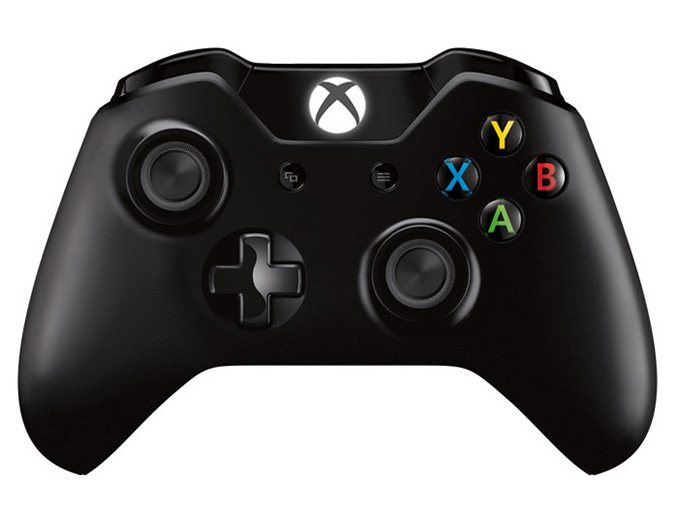
The Xbox One supports up to 8 wireless controllers, one of which is included in the box. By default the controllers take two AA batteries, although Microsoft will offer optional first party rechargeable batteries at launch. I didn’t get time to build a good battery life test for the One’s controllers, but Microsoft tells me you should expect somewhere around 30 hours of use on a single set of AAs.
The new controller is a clear evolution of the 360’s controller. There are three features that stood out to me in using the controller. For starters, the amount of initial resistance in each thumbstick has been dialed back considerably. The new thumbsticks are easier to use and less fatiguing as a result. Secondly, the new d-pad ditches the silly old platform that the old d-pad rested on. Instead you get a standard plus-arrangement. Each direction is accompanied by a shallow but pronounced click. It’s great for using the d-pad for issuing commands, but for fighting games I’d prefer something a little softer rather than discrete clicks. I feel like Microsoft likely picked the right tradeoff here as the days of Street Fighter, Mortal Kombat and Killer Instinct are long behind us, despite the latter making another appearance on the One.
The final improvement to the controller is the inclusion of what Microsoft is calling impulse triggers. The One’s controller features a total of four vibrating motors, one in each grip and one in each of the two big triggers (LT/RT). For games that choose to implement it, impulse trigger support is awesome. You get a subtle rumble that’s very focused on the triggers rather than your whole controller vibrating like crazy. I feel like force feedback in controllers is obviously here to stay, but it’s rarely used in a particularly subtle fashion. Instead what you normally run into is short bursts of feedback or long, agonizing vibration. NBA 2K14 appears to use the impulse triggers and the result is something in between, and something I really did appreciate.
For the first time since the introduction of the Xbox, Microsoft has done away with the back/start buttons and instead replaced them with view and menu buttons. They more or less serve the same functions, it’s just interesting to me how every major generation we come across an obvious desire to ditch select/start.
Performance - An Update
The Chipworks PS4 teardown last week told us a lot about what’s happened between the Xbox One and PlayStation 4 in terms of hardware. It turns out that Microsoft’s silicon budget was actually a little more than Sony’s, at least for the main APU. The Xbox One APU is a 363mm^2 die, compared to 348mm^2 for the PS4’s APU. Both use a similar 8-core Jaguar CPU (2 x quad-core islands), but they feature different implementations of AMD’s Graphics Core Next GPUs. Microsoft elected to implement 12 compute units, two geometry engines and 16 ROPs, while Sony went for 18 CUs, two geometry engines and 32 ROPs. How did Sony manage to fit in more compute and ROP partitions into a smaller die area? By not including any eSRAM on-die.
While both APUs implement a 256-bit wide memory interface, Sony chose to use GDDR5 memory running at a 5.5GHz data rate. Microsoft stuck to more conventionally available DDR3 memory running at less than half the speed (2133MHz data rate). In order to make up for the bandwidth deficit, Microsoft included 32MB of eSRAM on its APU in order to alleviate some of the GPU bandwidth needs. The eSRAM is accessible in 8MB chunks, with a total of 204GB/s of bandwidth offered (102GB/s in each direction) to the memory. The eSRAM is designed for GPU access only, CPU access requires a copy to main memory.
Unlike Intel’s Crystalwell, the eSRAM isn’t a cache - instead it’s mapped to a specific address range in memory. And unlike the embedded DRAM in the Xbox 360, the eSRAM in the One can hold more than just a render target or Z-buffer. Virtually any type of GPU accessible surface/buffer type can now be stored in eSRAM (e.g. z-buffer, G-buffer, stencil buffers, shadow buffer, etc…). Developers could also choose to store things like important textures in this eSRAM as well, there’s nothing that states it needs to be one of these buffers just anything the developer finds important. It’s also possible for a single surface to be split between main memory and eSRAM.
Obviously sticking important buffers and other frequently used data here can definitely reduce demands on the memory interface, which should help Microsoft get by with only having ~68GB/s of system memory bandwidth. Microsoft has claimed publicly that actual bandwidth to the eSRAM is somewhere in the 140 - 150GB/s range, which is likely equal to the effective memory bandwidth (after overhead/efficiency losses) to the PS4’s GDDR5 memory interface. The difference being that you only get that bandwidth to your most frequently used data on the Xbox One. It’s still not clear to me what effective memory bandwidth looks like on the Xbox One, I suspect it’s still a bit lower than on the PS4, but after talking with Ryan Smith (AT’s Senior GPU Editor) I’m now wondering if memory bandwidth isn’t really the issue here.
| Microsoft Xbox One vs. Sony PlayStation 4 Spec comparison | ||||||||||||||
| Xbox 360 | Xbox One | PlayStation 4 | ||||||||||||
| CPU Cores/Threads | 3/6 | 8/8 | 8/8 | |||||||||||
| CPU Frequency | 3.2GHz | 1.75GHz | 1.6GHz | |||||||||||
| CPU µArch | IBM PowerPC | AMD Jaguar | AMD Jaguar | |||||||||||
| Shared L2 Cache | 1MB | 2 x 2MB | 2 x 2MB | |||||||||||
| GPU Cores | 768 | 1152 | ||||||||||||
| GCN Geometry Engines | 2 | 2 | ||||||||||||
| GCN ROPs | 16 | 32 | ||||||||||||
| GPU Frequency | 853MHz | 800MHz | ||||||||||||
| Peak Shader Throughput | 0.24 TFLOPS | 1.31 TFLOPS | 1.84 TFLOPS | |||||||||||
| Embedded Memory | 10MB eDRAM | 32MB eSRAM | - | |||||||||||
| Embedded Memory Bandwidth | 32GB/s | 102GB/s bi-directional (204GB/s total) | - | |||||||||||
| System Memory | 512MB 1400MHz GDDR3 | 8GB 2133MHz DDR3 | 8GB 5500MHz GDDR5 | |||||||||||
| System Memory Bus | 128-bits | 256-bits | 256-bits | |||||||||||
| System Memory Bandwidth | 22.4 GB/s | 68.3 GB/s | 176.0 GB/s | |||||||||||
| Manufacturing Process | 28nm | 28nm | ||||||||||||
In order to accommodate the eSRAM on die Microsoft not only had to move to a 12 CU GPU configuration, but it’s also only down to 16 ROPs (half of that of the PS4). The ROPs (render outputs/raster operations pipes) are responsible for final pixel output, and at the resolutions these consoles are targeting having 16 ROPs definitely puts the Xbox One as the odd man out in comparison to PC GPUs. Typically AMD’s GPU targeting 1080p come with 32 ROPs, which is where the PS4 is, but the Xbox One ships with half that. The difference in raw shader performance (12 CUs vs 18 CUs) can definitely creep up in games that run more complex lighting routines and other long shader programs on each pixel, but all of the more recent reports of resolution differences between Xbox One and PS4 games at launch are likely the result of being ROP bound on the One. This is probably why Microsoft claimed it saw a bigger increase in realized performance from increasing the GPU clock from 800MHz to 853MHz vs. adding two extra CUs. The ROPs operate at GPU clock, so an increase in GPU clock in a ROP bound scenario would increase performance more than adding more compute hardware.
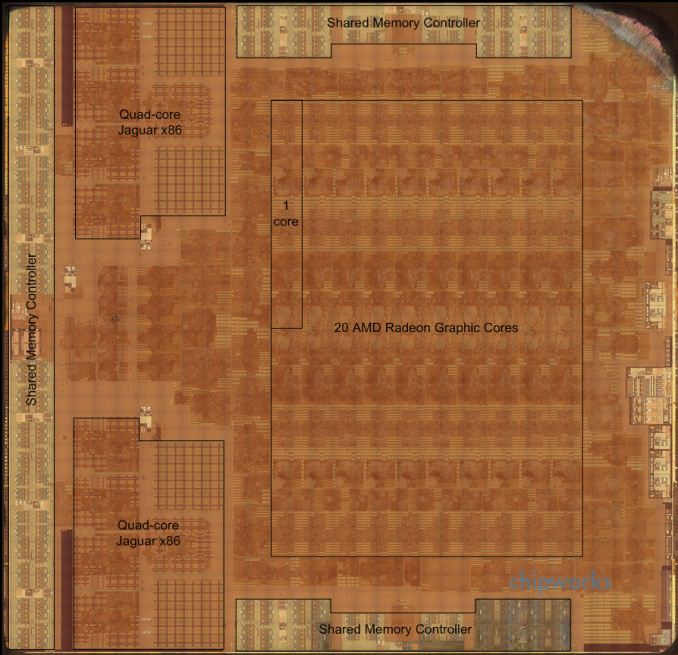 The PS4's APU - Courtesy Chipworks
The PS4's APU - Courtesy Chipworks
Microsoft’s admission that the Xbox One dev kits have 14 CUs does make me wonder what the Xbox One die looks like. Chipworks found that the PS4’s APU actually features 20 CUs, despite only exposing 18 to game developers. I suspect those last two are there for defect mitigation/to increase effective yields in the case of bad CUs, I wonder if the same isn’t true for the Xbox One.
At the end of the day Microsoft appears to have ended up with its GPU configuration not for silicon cost reasons, but for platform power/cost and component availability reasons. Sourcing DDR3 is much easier than sourcing high density GDDR5. Sony managed to obviously launch with a ton of GDDR5 just fine, but I can definitely understand why Microsoft would be hesitant to go down that route in the planning stages of Xbox One. To put some numbers in perspective, Sony has shipped 1 million PS4s thus far. That's 16 million GDDR5 chips, or 7.6 Petabytes of RAM. Had both Sony and Microsot tried to do this, I do wonder if GDDR5 supply would've become a problem. That's a ton of RAM in a very short period of time. The only other major consumer of GDDR5 are video cards, and the number of cards sold in the last couple of months that would ever use that RAM is a narrow list.
Microsoft will obviously have an easier time scaling its platform down over the years (eSRAM should shrink nicely at smaller geometry processes), but that’s not a concern to the end user unless Microsoft chooses to aggressively pass along cost savings.
Image Quality - Xbox 360 vs. Xbox One
Before I get to the PS4 comparison, I wanted to start with some videos showcasing the improvement you can expect from launch day titles that are available on both the Xbox 360 and Xbox One. I turned to Call of Duty: Ghosts for this comparison as it’s broadly available on all platforms I’m comparing today.
Note that cross platform launch titles, particularly those available on previous generation consoles, end up being the worst examples of what’s possible on a next-generation platform. For the most part they’re optimized for the platform with the larger installed base (i.e. prior-gen hardware), and the visual uplift on new hardware isn’t as much as it could be. I’d say my subjective experience in playing a lot of the launch titles on Xbox One and PS4 mirrors this sentiment. Basic things like not having accurate/realistic cloth physics in games like CoD: Ghosts just screams port and not something that was designed specifically for these next gen systems. Just as we’ve seen in prior generations, it’s likely going to be a good 12 - 24 months before we see great examples of games on this new generation of hardware.
Now that I’ve adequately explained why this is a bad comparison, let’s get to the comparison. I’ve captured HDMI output on both consoles. They were both set to full range (0-255), however I had issues with the Xbox One respecting this setting for some reason. That combined with differences across Ghosts on both platforms left me with black levels that don’t seem equalized between the platforms. If you can ignore that, we can get to the comparison at hand.
All of these videos are encoded at 4K, with two 1080p captures placed side by side. Be sure to select the highest quality playback option YouTube offers.
The first scene is the intro to Ghosts. Here you can see clear differences in lighting, details in the characters, as well as some basic resolution/AA differences as well (Xbox 360 image sample, Xbox One image sample).
The second scene is best described as Call of Duty meets Gravity. Here the scene is going by pretty quickly so you’re going to have to pause the video to get a good feel for any differences in the platforms. What’s most apparent here though is the fact that many present day users can likely get by sticking with older hardware due to the lack of titles that are truly optimized for the Xbox One/PS4.
Now getting to scenes more representative of actual gameplay, we have Riley riding around wanting badly to drive the military vehicle. Here the differences are huge. The Xbox One features more realistic lighting, you can see texture in Riley’s fur, shadows are more detailed and there seems to be a resolution/AA advantage as well. What’s funny is that although the Xbox One appears to have a resolution advantage, the 360 appears to have less aliasing as everything is just so blurry.
Speaking of aliasing, we have our final IQ test which is really the perfect test case for high resolution/AA. Once again we see a completely different scene comparing the Xbox One to Xbox 360. Completely different lighting, much more detail in the environments as well as objects on the ground. The 360 version of Ghosts is just significantly more blurry than what you get on the One, which unfortunately makes aliasing stand out even more on the One.
Even though it’ll be a little while before we get truly optimzed next-gen titles, there’s an appreciable improvement on those games we have today for anyone upgrading from an older console. The difference may be more subtle than in previous generations, but it’s there.
Image Quality - Xbox One vs. PlayStation 4
This is the big one. We’ve already established that the PS4 has more GPU performance under the hood, but how does that delta manifest in games? My guess is we’re going to see two different situations. The first being what we have here today. For the most part I haven’t noticed huge differences in frame rate between Xbox One and PS4 versions of the same game, but I have noticed appreciable differences in resolution/AA. This could very well be the One’s ROP limitations coming into play. Quality per pixel seems roughly equivalent across consoles, the PS4 just has an easier time delivering more of those pixels.
The second situation could be one where an eager developer puts the PS4’s hardware to use and creates a game that doesn’t scale (exclusively) in resolution, but also in other aspects of image quality as well. My guess is the types of titles to fall into this second category will end up being PS4 exclusives (e.g. Uncharted 4) rather than something that’s cross-platform. There’s little motivation for a cross-platform developer to spend a substantial amount of time in optimizing for one console.
Call of Duty: Ghosts
Let’s start out with Call of Duty: Ghosts. Here I’m going to focus on two scenes: what we’ve been calling internally Let the Dog Drive, and the aliasing test. Once again I wasn’t able to completely normalize black levels across both consoles in Ghosts for some reason.
In motion both consoles look pretty good. You really start to see the PS4’s resolution/AA advantages at the very end of the sequence though (PS4 image sample, Xbox One image sample). The difference between these two obviously isn’t as great as from the 360 to Xbox One, but there is a definite resolution advantage to the PS4. It’s even more obvious if you look at our aliasing test:
Image quality otherwise looks comparable between the two consoles.
NBA 2K14
NBA 2K14 is one cross platform title where I swear I could sense slight frame rate differences between the two consoles (during high quality replays) but it’s not something I managed to capture on video. Once again we find ourselves in a situation where there is a difference in resolution and/or AA levels between the Xbox One and PS4 versions of the game.
Both versions look great. I’m not sure how much of this is the next-gen consoles since the last time I played an NBA 2K game was back when I was in college, but man have console basketball games significantly improved in their realism over the past decade. On a side note, NBA 2K14 does seem to make good use of the impulse triggers on the Xbox One’s controller.
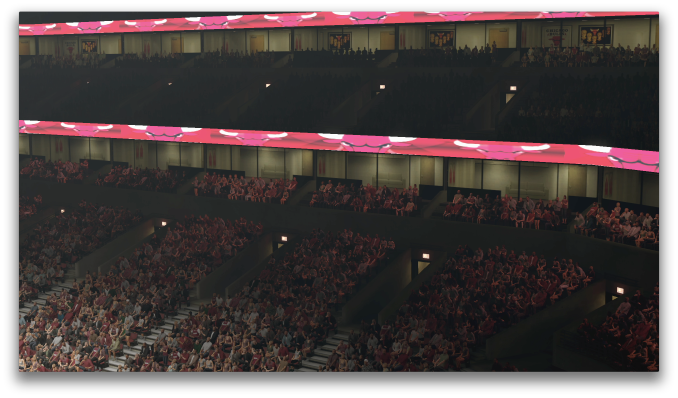
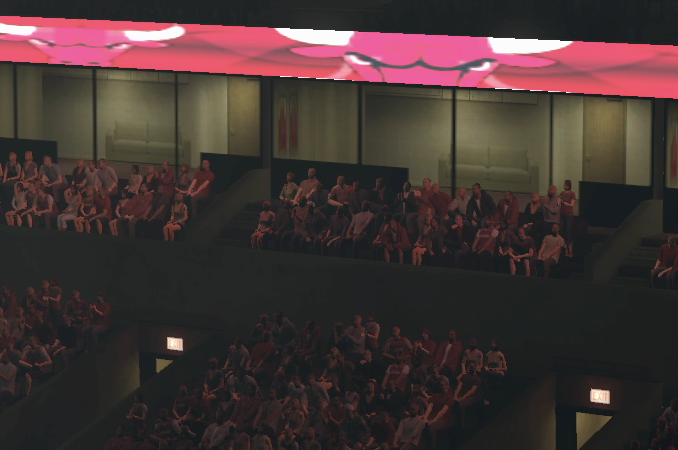
Battlefield 4
I grabbed a couple of scenes from early on in Battlefield 4. Once again the differences here are almost entirely limited to the amount of aliasing in the scene as far as I can tell. The Xbox One version is definitely more distracting. In practice I notice the difference in resolution, but it’s never enough to force me to pick one platform over another. I’m personally more comfortable with the Xbox One’s controller than the PS4’s, which makes for an interesting set of tradeoffs.
Power Consumption
As always I ran the Xbox One through a series of power consumption tests. I’ve described the tests below:
Off - Console is completely off, standby mode is disabled
Standby - Console is asleep, can be woken up by voice commands (if supported). Background updating is allowed in this mode.
Idle - Ethernet connected, no disc in drive, system idling at dashboard.
Load (BF4) - Ethernet connected, Battlefield 4 disc in drive, running Battlefield 4, stationary in test scene.
Load (BD Playback) - Ethernet connected, Blu-ray disc in drive, average power across Inception test scene.
CPU Load - SunSpider - Ethernet connected, no disc in drive, running SunSpider 1.0.2 in web browser.
CPU Load - Kraken - Ethernet connected, no disc in drive, running Kraken 1.1 in web browser
| Power Consumption Comparison | |||||||
| Total System Power | Off | Standby | Idle | Load (BF4) | Load (BD Playback) | ||
| Microsoft Xbox 360 Slim | 0.6W | - | 70.4W | 90.4W (RDR) | - | ||
| Microsoft Xbox One | 0.22W | 15.3W | 69.7W | 119.0W | 79.9W | ||
| Sony PlayStation 4 | 0.45W | 8.59W | 88.9W | 139.8W | 98.0W | ||
When I first saw the PS4’s idle numbers I was shocked. 80 watts is what our IVB-E GPU testbed idles at, and that’s with a massive 6-core CPU and a Titan GPU. Similarly, my Haswell + Titan CPU testbed has a lower idle power than that. The Xbox One’s numbers are a little better at 69W, but still 50 - 80% higher than I was otherwise expecting.
Standby power is also surprisingly high for the Xbox One. Granted in this mode you can turn on the entire console by saying Xbox On, but always-on voice recognition is also something Motorola deployed on the Moto X and did so in a far lower power budget.
The only good news on the power front is really what happens when the console is completely off. I’m happy to report that I measured between 0.22 and 0.45W of draw while off, far less than previous Xbox 360s.
Power under load is pretty much as expected. In general the Xbox One appears to draw ~120W under max load, which isn’t much at all. I’m actually surprised by the delta between idle power and loaded GPU power (~50W). In this case I’m wondering if Microsoft is doing much power gating of unused CPU cores and/or GPU resources. The same is true for Sony on the PS4. It’s entirely possible that AMD hasn’t offered the same hooks into power management that you’d see on a PC equipped with an APU.
Blu-ray playback power consumption is more reasonable on the Xbox One than on the PS4. In both cases though the numbers are much higher than I’d like them to be.
I threw in some browser based CPU benchmarks and power numbers as well. Both the Xbox One and PS4 ship with integrated web browsers. Neither experience is particularly well optimized for performance, but the PS4 definitely has the edge at least in javascript performance.
| Power Consumption Comparison | ||||||
| Lower is Better | SunSpider 1.0.2 (Performance) | SunSpider 1.0.2 (Power) | Kraken 1.1 (Performance) | Kraken 1.1 (Power) | ||
| Microsoft Xbox One | 2360.9 ms | 72.4W | 111892.5 ms | 72.9W | ||
| Sony PlayStation 4 | 1027.4 ms | 114.7W | 22768.7 ms | 114.5W | ||
Power consumption while running these CPU workloads is interesting. The marginal increase in system power consumption while running both tests on the Xbox One indicates one of two things: we’re either only taxing 1 - 2 cores here and/or Microsoft isn’t power gating unused CPU cores. I suspect it’s the former, since IE on the Xbox technically falls under the Windows kernel’s jurisdiction and I don’t believe it has more than 1 - 2 cores allocated for its needs.
The PS4 on the other hand shows a far bigger increase in power consumption during these workloads. For one we’re talking about higher levels of performance, but it’s also possible that Sony is allowing apps access to more CPU cores.
There’s definitely room for improvement in driving down power consumption on both next-generation platforms. I don’t know that there’s huge motivation to do so outside of me complaining about it though. I would like to see idle power drop below 50W, standby power shouldn’t be anywhere near this high on either platform, and the same goes for power consumption while playing back a Blu-ray movie.
Final Words
More so than last time, it seems like this next generation of console wars will boil down to a few key questions: exclusives, online, extra features and personal preference.
If there’s an exclusive IP that you will sink a ton of time into, the rest really doesn’t matter. For Microsoft that could be Halo, for Sony that could be Uncharted. I feel like Microsoft might have the stronger lineup out of the gate this generation, but that’s not saying much as neither platform appears to have anything that’s a must have at this point. I can’t help but wonder how different this launch would’ve been had there been a Halo 5 or Uncharted 4 (or Last of Us 2) available on day one.
The online story is going to take some time to flesh out. Microsoft held the clear advantage there last generation for online multiplayer, but Sony is intent on closing the gap this round. I’m going to say it’s still wait and see on this one as neither console is going to have enough users to make for a great online experience for a while to come.
In the extra features category, Microsoft is really hoping to win users over with things like their TV integration and Kinect. I couldn’t be further from the right demographic to talk about the former so I’m going to avoid saying much there. On the Kinect front, I know people who are interested in the Xbox One solely because of Kinect. I’m not one of those people but I can definitely see the appeal there. If Sony’s price tag didn’t nerf the PS3 last round, it’s entirely possible that Microsoft’s Kinect bundle and resulting price hike won’t do the same for the Xbox One this time.
Finally, there’s an element of personal preference in all of this. Look, feel, ecosystem, company loyalty all fall into this category. There are also things like controller preference that fit here as well. I can’t help much in this department.
If you’re looking at the Xbox One as a successor to the Xbox 360, I think you’ll be very pleased. It’s a much better console in every way and a long overdue upgrade.
It's interesting to me that the performance/image quality differences that exist between the Xbox One and PS4 ultimately boil down to a difference in memory interface rather than an interest in optimizing down silicon cost. In this case Microsoft has the bigger die, but the smaller GPU in order to accommodate enough eSRAM to offset the use of DDR3 memory.
If all you play are cross-platform games, then the PS4 will give you better looking titles at a lower console cost. For those of you that are particularly bothered by aliasing, the PS4 will definitely reduce (not eliminate) that. However I would argue that if all you play are cross-platform games then you might want to look into buying/building a PC instead. I’m also unsure about how much cross shopping actually happens between these two platforms. I can understand for first time gamers (e.g. parents buying the first console for their kids), but otherwise I feel like your friend group and prior experience is going to ultimately determine whether you end up with a Xbox One or PS4.
I need a Halo box, but I also like to play Uncharted. Unfortunately I don’t know that there’s a good recommendation one way or another, other than to wait for a bit. Being an early adopter of a next-gen console is rarely a fun thing. Literally all of my friends are on Xbox 360s or PS3s, meaning online multiplayer with people I know is pretty much out of the question for at least a year or so. The launch lineup for both platforms is reasonable but could be a lot better. Having just played Grand Theft Auto V and the Last of Us, I’m going to need more than CoD or NBA 2K14 to really draw me in to the Xbox One or PS4. This is how the story goes with any new console launch.
One thing is for sure - this generation was long overdue. I remember being at E3 in 2005 and wondering what the Xbox 360 and PS3 would do to the future of PC gaming given how well specced both systems were. This time around I’m less concerned. Everyone seems to have gone more conservative with GPU choices, even though the resulting APUs are anything but small. If anything the arrival of both consoles, targeted the way they are, is likely going to make things better industry wide. As both sell in good quantities we’ll see developers target a higher class of system, which will be good for everyone.

